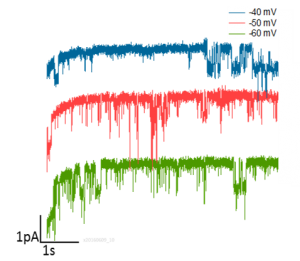
Ion channels are trans-membrane proteins, which allow movement of ions (cations and anions) into and out of cells. These channels are involved in many metabolic processes such as cell homeostasis and signal transduction and play a crucial role in numerous diseases including those of the nervous system, gastrointestinal tract and skin as well as chronic pain. Therefore, targeting ion channels with specific modulators holds great potential for disease management. However, development of such modulators is very challenging as conventional drug screening methods cannot be used.
As opposed to the human sector, ion channel research in the veterinary field is still in its infancy. For most species, neither the ion channel gene sequences nor their functional expression patterns, which are known to vary significantly among species, are known. Thus, activities of ion channel modulators developed for human use, may vary in veterinary species. Therefore, ion channel modulators need to be developed specifically for veterinary field.
PerformaNat is specialized in developing ion channel modulators that can be used in animal feed to improve the health status. The company’s core strength is the substantial expertise and long-standing experience in characterizing ion channels across species as well as screening product candidates in cell models with transport- and electrophysiological methods. PerformaNat has advanced several product candidates into clinical testing.
One important type of channel is the so-called “transient receptor potential” (TRP) family, which belongs to the group of non-selective cation channels.
TRP-channel
The name “transient receptor potential” is derived from a mutant Drosophila melanogaster fruit fly (trp343), which has only a transient polarization following light stimulus. The TRP protein was found to be responsible. TRP channels are special among ion channels as they can be stimulated by temperature change, specific ligands and second messengers. Since approximately 20% of all channels in the body are TRP channels, modulating their function has enormous potential to affect health and disease. PerformaNat is focused on the identification and characterization of active ingredients that affect TRP channels and can be used in feed additives.
Transport – and Electrophysiology
 Not much is known about the role of TRP channels in livestock species. For the evaluation of ion channel functions, complex methods are required.
Not much is known about the role of TRP channels in livestock species. For the evaluation of ion channel functions, complex methods are required.
Electrophysiological techniques such as Patch Clamp and Ussing chamber measurements enable us to study the activity of a single TRP channel and to identify specific modulators. Due to the fact that TRP channel modulators are very species-specific and their effect is strongly dose-depending, numerous experiments are required to identify potential candidates for further product development trials.
In addition to single cell studies, electrophysiological measurements with vital gastrointestinal tissues are necessary to characterize the function of ion channels and the effect of potential modulators on the epithelial barrier. By using radioactive isotopes in the Ussing chamber, the nutrient transport across the epithelium can be analyzed. Furthermore, dose-effect studies can be performed. Based on the results from electrophysiology, the most promising modulators can be tested in feeding studies.

The analytics department performs qualitative, quantitative and structural analysis of ingredients. First, compounds are analyzed qualitatively followed by quantification. The next step is a detailed analysis of the chemical structure.
The main goal is the identification of biomarkers, which are dependent on the state of the metabolism. Chromatographic methods such as high performance liquid chromatography (HPLC) and column chromatography are used. These methods allow separation of complex mixtures, identification of the separated compounds and quantification of these.
In order to lower the limit of detection of ingredients that are difficult to detect, chemical modifications are made and ion concentrations are determined. Using spectrometry, novel active ingredients are characterized and quantified with a view to use these substances for product development.

Using molecular biology methods, target gene expression by herbal compounds in various tissues is determined semi-quantitatively. Additionally, extensive screening of potential modulators in cell culture models or ex vivo experiments are conducted.

Besides expression analysis of proteins and other biomarkers using q-RT-PCR, complementary western blots and ELISAs experiments are conducted. As there are only very few assays available for farm animal species, PerformaNat is looking for developing novel detection methods.
